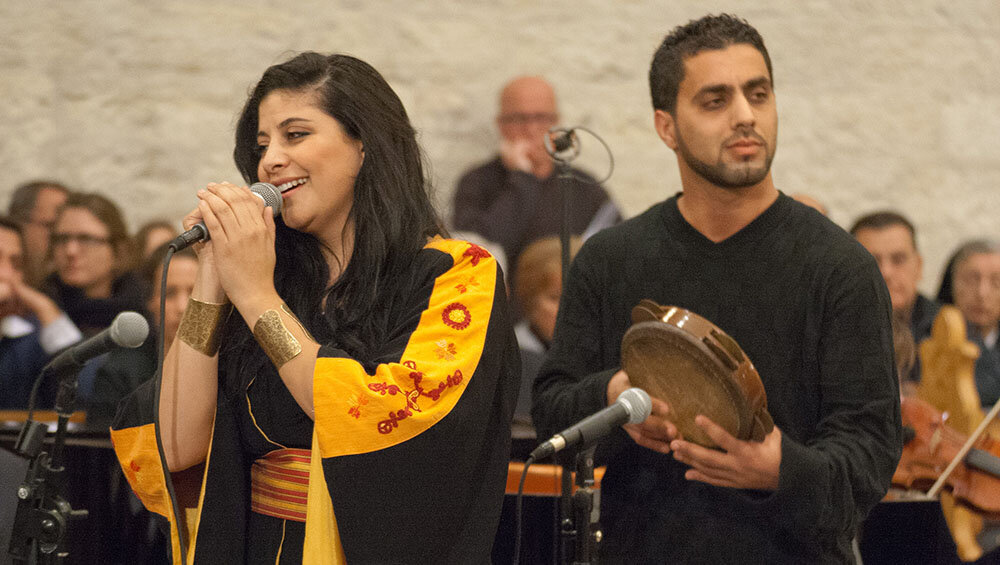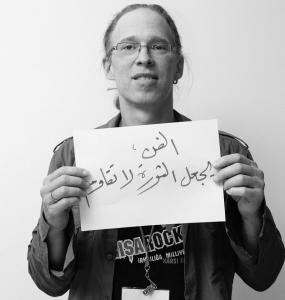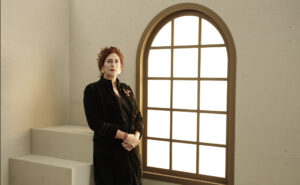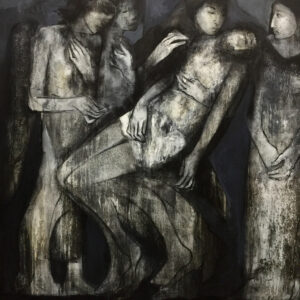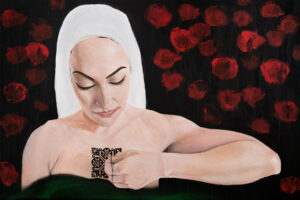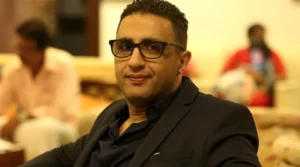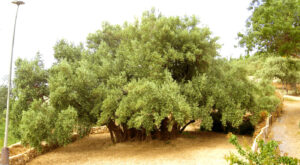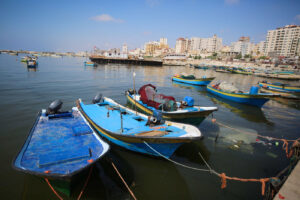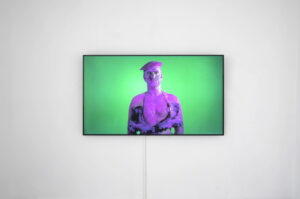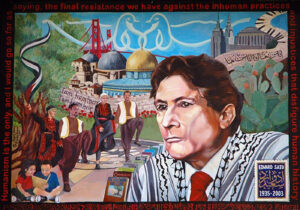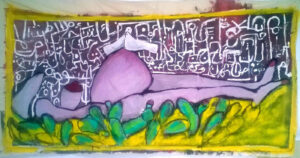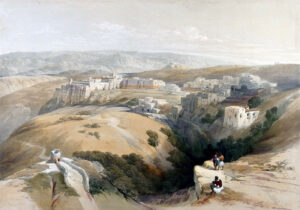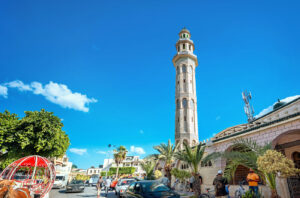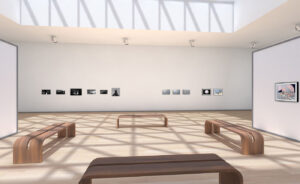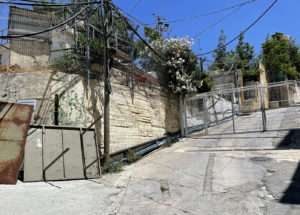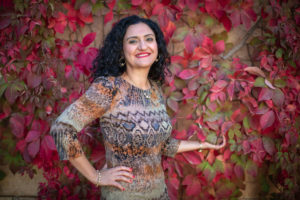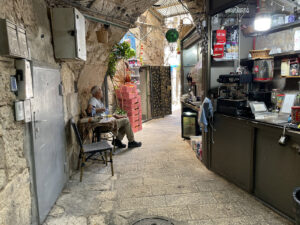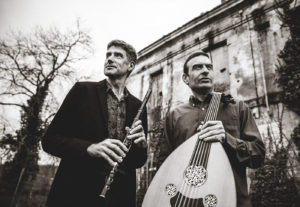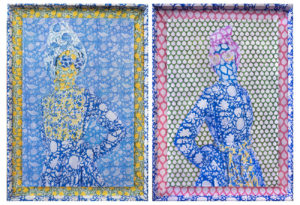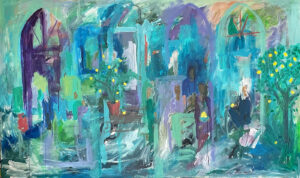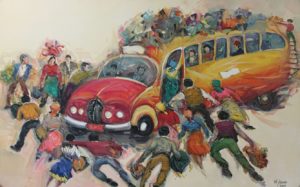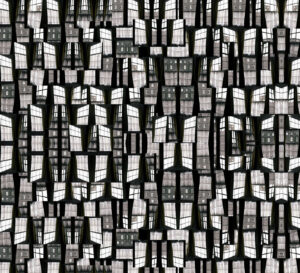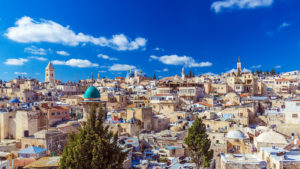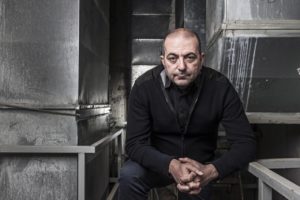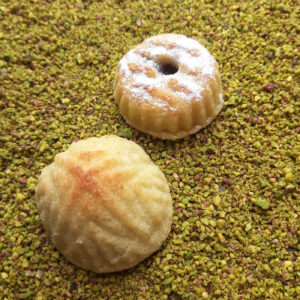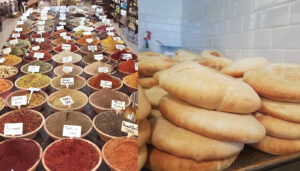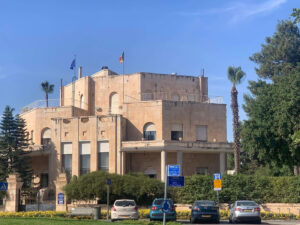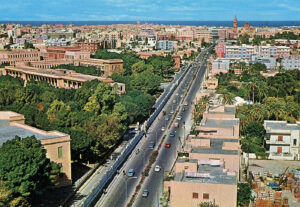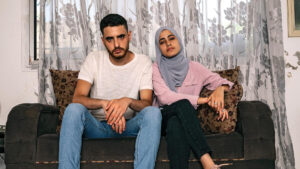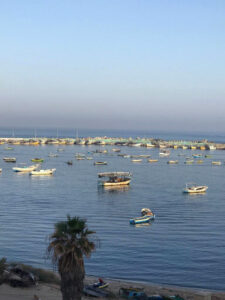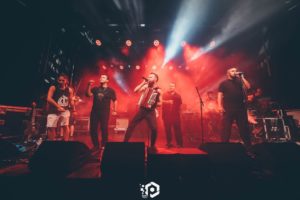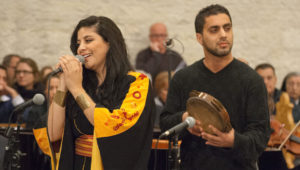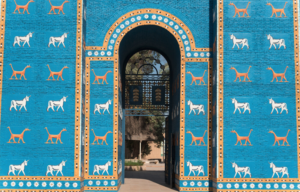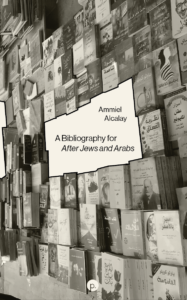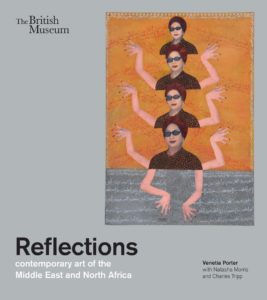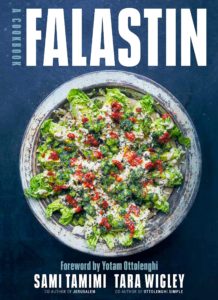Middle East historian and musician Mark LeVine interviews Nili Belkind, ethnomusicologist and author of Music in Conflict: Palestine, Israel, and the Aesthetics of Production. Read a review of the book here.
Mark LeVine
Nili, please give us some background on yourself and how you came to write this book.
I was born in Israel and left when I was 20. I then lived in the US for 35 years before I came back to live in Jaffa. I left because it was very hard for me to accept what happened here during the Lebanon war, especially after [the massacres that took place in the refugee camps of] Sabra and Shatila [under the averted gaze of the Minister of Defense at the time Ariel Sharon]. However, you can leave a place, but the place never leaves you… and my family is here, I’d come all the time to visit them, I was connected to all the music that was happening here. I worked in the music industry in the US for many years, and being in touch with music scenes here was part of my work as well. So there are things that keep drawing you back to where you’re from.
In my previous musical life I mostly worked with Caribbean music — French and Spanish Caribbean. And I remember the day I came back here in 2008-09. I was putting the finishing touches on my MA thesis which was about Haitian artists in the diaspora. I flew through Jordan and while I was at the airport in Jordan, I saw on the TV news how the war on Gaza had started that day. This was the so-called “Grapes of Wrath” operation. I felt that pit in my stomach open up again. The rest of my time here, which I spent visiting family and putting finishing touches on my thesis — which meant thinking about Duvalier and Vodun and Haitian music and colonial legacies in general — was the same time that everything here became so extreme and hyper-nationalized and angry and hateful. It was hard for me to take but it was also the moment I knew I was coming back here for my dissertation and that I wasn’t going to continue with the Caribbean during my PhD.
This is the beginning of how I came to write this book. By 2011, I returned to do fieldwork in Palestine-Israel. And part of how and why I went about doing fieldwork was of course related to who I am. On the one hand there is being from here, and on the other hand there is having been away from here for so long, in a way that I think allowed me to perhaps transcend the tribal or nationalistic frames with which people here approach those who are not part of their group. I was coming to this from a very post-nationalist or even anti-nationalist disposition, which is of course why I haven’t lived here for so long. I always had trouble accepting the roles that collective belonging imposed on one’s being in this place, and the attendant violence and inequalities that are part and parcel of this.
What do you mean on page 2 when you explain your goal is exploring “the contemporary relationship between musical production and political life in the context of the protracted, violent conflict, which for over a century has both shaped and claimed the lives of Palestinians and Jews in Palestine-Israel”?
I think that a lot of work has been written from either a Palestinian narrative or a Jewish/Israeli one. And no matter who is the more powerful side — although clearly it is Israel and Jewish Israelis — I think the conflict, or the occupation, or the hatred, or whichever angle you want to look at these things from, shapes everybody, everyone’s identities, everyone’s lives. As much as people try to step away from this idea, for me this understanding also means that Jewish Israelis and Palestinians are shaped by each other. And that’s what I try to bring out in the book.
Can you explain what these two excerpts from early in the book mean for understanding the production, circulation and consumption of music today on both sides of the Green Line:
“As numerous scholars (Donnan and Wilson 1999; Morehouse 2004; New-man 2006; Rumford 2006; Salter 2006; van Houtum 2010) have pointed out, borders are material technologies and manifestations of spatial regimes of power” (p. 4) and “Literature about borders focuses on the architecture and infrastructures of power, domination and violence enforced by nation states, my objective is to explore how sound and expressive culture intersect with their physical and social effects” (p. 5)?
The ways that borders are authored in Israel-Palestine, or Palestine-Israel are very much about power and enforcing domination on other people. But the assertion of power and hegemony is never a completed project. In the book I look at how physical borders and social boundaries intersect but I also show that music travels and circulates in ways that often don’t just work with or against power and domination and that can shape identities in different ways, ways that reshape the borders and social boundaries. One example of how music travels across borders in ways we don’t necessarily expect includes [what I hear from] my Palestinian neighbors in the apartment across from me. When I hear the guy singing to himself in the shower —he’s either singing musika mizrahit, Mizrahi music [in Hebrew], or anasheed, religious chants in Arabic. The ways that music becomes something in people’s lives—something that matters to them, something that might be the most intimate thing you can sing in the shower—does not necessarily align with how material borders or social boundaries are imposed on you or your identity.
Another example is a 13-year-old blind child from Salem village near Nablus who told me his favorite singer of all time is Zohar Argov, the mizrahi artist. Argov, who died in 1987, is not contemporaneous with this kid I met in 2012. But Argov has carried a lot of meaning for some Palestinians, and his music has become part of the generic space that they consider their own too. That’s another example of how music transgresses the power of authoritative borders.
A third example could be the Al-Kamandjâti Youth Orchestra performance that I speak about in Chapter 3, when the orchestra actually goes to perform at Qalandiya check point and they’re performing classical Western music. What they’re doing is bringing something that is so very coherent, so group oriented, in a very collective moment, and all of this is juxtaposed with the kind of “noise” that the checkpoint produces through loudspeakers, where the orders barked at passengers are oftentimes unintelligible and therefore dangerous, because of what can happen to people who “don’t listen”… What is going on here is the juxtaposition of the civilized Palestinian, and the uncivilized Israeli apparatus of power and borders — as checkpoints create borders, and the Youth orchestra here reclaims the space as Palestinian.
When people share a geographical space, there’s a certain kind of cultural intimacy that takes place that occurs through the airwaves, through sound and music. Mediated sound can change its meaning across borders, but borders can’t stop it. And if we actually start to map the sounds, the sonic spaces, the musical variety, we find that borders shift, they move, they’re subverted or asserted. We find all kinds of things about borders that we don’t find just through looking solely at imposed borders.
As the possibilities of a two-state solution and cooperation have slipped to near zero, what does it mean on p. 6 when with reference to the Legacy Band that “cultural production is hence intimately connected to the intersection of foreign diplomacy and projected interests, evangelical and/or political, with local moves and desires”? Is this still the case and if not, how has it changed?
You’re absolutely right about the possibility of a two-state solution having slipped to near zero. I think what you’re pointing out here is how much US policy has changed, which is part of what is at stake. When I was doing fieldwork and the Legacy Band was here — it was sent by the US State Department to all kinds of “strife areas” including Tunisia. Sudan and Palestine, although they called it “Israel.” This was interesting because they actually played only in Palestinian locales in West Bank and Palestinian towns in Israel, but the State Department nevertheless called it playing in “Israel.” Sending these musicians abroad is an interesting part of US policy which is about US soft-power… in the past it was mostly jazz that represented the US, but not only. Such goodwill gestures towards Palestinians completely changed under Trump with his overwhelming support for Israel and total dissing of Palestinians.
In the short run, I think that US foreign diplomacy has changed. In the long run, perhaps not. With the Biden administration we’ll start seeing support for culture in the West Bank, and other ways for USAID going into the West Bank if not Gaza, in order to assert US power in the region again but without upsetting the power structure. But I do think that the intersection of foreign diplomacy and projected interests —evangelical and political — with cultural production in the region, is not a momentary thing determined by one administration or another. This is the Holy Land, it’s always been very meaningful to the West, not just the Americans but Europe too, and it will continue to be very meaningful. I speak more concertedly about this issue in an article developed from a chapter that was cut from the book, about how cultural production in the West Bank has been supported and enabled since the Oslo period by Europe and the US mostly, as well as folks interested in the Holy Land. The article discusses a Christmas concert that takes place at the Nativity Church, which an Italian NGO presented as a “peace concert” and which the Edward Said National Conservatory of Music — whose Palestine Youth Orchestra performed there with some Italian soloists — turned into a defiant display that was about Palestinian liberation, rather than Western interventions promoting “peace building. So evangelical issues are a part of it to this day, and mission is a part of it, as are foreign powers, and it will continue to be so. But in terms of short-term differences, yes, the Trump administration closed down a lot of the support previously given to culture in Palestine and it remains to be seen what happens with the Biden administration.
You are from an extended Jewish and Palestinian family. How does this impact your exploration of “the dissonances that arise when personal geographies do not align with the imposed borders and social boundaries perpetuated by the conflict” on p. 7? what happens when you meet a Palestinian counterpart with a similar biography? And how does it impact “local regimes of knowledge… the ways in which borders and social boundaries have been naturalized into conceptions of Self and Other.” And how would you compare your experience, for example, with Juliano Mer-Khamis’ vis-a-vis theater and particularly the Freedom Theatre in Jenin?
Let’s start with the first part of your question: I already came very formed to my study in the sense that I lived away from here by choice. I lived in New York where everybody is from somewhere else and where everyone’s an expat or foreigner, no one is a native, no one has further rights [to the place] than anyone else. That’s how New York always felt, at least to me. And having lived there longer than I lived anywhere else, it took me away from the kinds of tribal affiliations that are so potent and over-determinant here, for both Palestinians and Jewish Israelis. I “discovered” my Palestinian family while I was here doing research in 2011, or more accurately, it was both families that discovered each other and became one again. It didn’t really change my perspective on things, but it was strange and almost eery, because quite a few people I already knew as friends or musicians — people that I traveled with became relatives of 2nd or 3rd or 4th degrees. So suddenly my geography changed: I had family in Nazareth, Eilabun, Ramallah. That was interesting, and it was unusual in that it was happening at the very same time my research was going on. I remember sitting with a distant cousin who runs a forum theater, the Ashtar Theatre, in Ramallah, and we’re talking about which angle of the story we’d start with if we were making a film about the family. I had been working in Ramallah for several months beforehand, and I had no idea I had family there.
While my new family didn’t really change my view of the world, in the field however, it did sometimes shift how other people viewed me, or my position, in subtle ways. Jewish leftist activists would tell me they were jealous of my having Palestinian relatives. In the West Bank I became a different kind of insider/outsider for some folks.
What happens with a Palestinian counterpart? In terms of my own family, which is what I can speak about, the reactions were very different. There are some members of our Palestinian family that became completely integrated with my own, like it was the missing part that was always not there but we somehow didn’t know it was missing, including my cousin Hanan and her parents Selim and Camilia, and we’ve become very close. But I don’t know who has a similar biography to me so it’s hard to answer your question beyond my experience. But I think that all these things do impact local regimes of knowledge. My father, for example, who has not been exposed to many Palestinians before, now maybe has a second sense of what it’s like to live in Israel as a minority that’s always being rejected in different ways, and he perhaps had not known what this truly means and feels like beforehand.
How would I compare my experience to Juliano’s? That’s a tough comparison… Juliano was a legend. His story is — well, he never left the country to live abroad. He was always here. And he was such a very powerful figure who meant so much to so many people in so many communities, I can’t even begin to approach anything like that. My story is very minor, hasn’t been told and isn’t known.
But I think that Juliano was also a torn person, in a way that perhaps I’m not because I’ve spent so much time away from here. Living the way he lived meant always being on the edge. I only started doing that when I came to do my research. But Juliano created something that outlived him and is bigger than him. And I hope my book resonates in maybe much smaller ways, but in ways that cross the divide—not in the typical way that people expect it to. Not in the frames of coexistence or other frames that are hegemonically constructed. Perhaps in this way —in the refusal to live within imposed borders and boundaries — I share something, maybe a tiny little thing, with Juliano’s legacy.
Related to your discussion on p. 22 of the book, what and where are the “spaces in between” and the “third time-space zone” in between performing resistance and coexistence?
Performing resistance and performing coexistence in the ways that have been mapped out in my book — are typically associated with hegemonic discourses in both Israel and Palestine. In the case of coexistence, of its politics, it usually happens in places in Israel that have mixed environments, Palestinian and Jewish, and in projects that use the arts as the way of promoting shared life in ways that are institutionally oriented and promote a multiculturalist, harmonious aesthetic. And the places where I heard a lot about music and resistance in Palestine are also arts organizations — conservatories that teach classical Western and Arabic musics. These organizations perform acts of resistance through music and conceive of it as part of what they do in their everyday musical production. These are new sites for studying formations of resistance and nation-making. When it comes to Palestinian music, people usually turn to Palestinian hip hop to look at resistance. After dabke and folklore, hip hop the most prominent genre associated with resistance politics in Palestine.
So I look at these sites, but I also look at all kinds of border zones that don’t quite align with either of these discourses. For example, spaces of co-resistance. I speak in the book about a concert in support of Dahamesh, a Palestinian village that is inside Israel but is not a “recognized village” and therefore doesn’t get any services from the government such as electricity or paved roads, nor are its residents allowed to build there. When I went to a demonstration and concert in support of all the Dahamesh people who were trying stop the demolition of their homes, the concert included Toot Ard, a Druze band from the Golan/Jawlan, a classical Arabic music ensemble from Nazareth, and the hip hop ensembles DAM and System Ali. And there were all these people, Palestinians and Jews who were there and who chanted in solidarity, on the ground, with the people of Dahamesh.
This was an act of co-resistance, which doesn’t quite fit with either institutional politics (the depoliticized politics of coexistence for example) nor with hegemonic discourses of resistance or coexistence. It also doesn’t fit with the aesthetic frames these discourses tend to go with. Here you can have a classical Arabic music ensemble promoting something at the same time a reggae band is also promoting it. So there’s a kind of alignment of aesthetics and discourse in institutional initiatives and in hegemonic narratives, but the spaces “in between” and the “third time-space zones” don’t quite work in the same way, aesthetically or discursively.
Other things I want to highlight when I speak about the third time-space zone are mixed places like Jaffa or Lydd where there is a kind of opening for things that again don’t materialize, or dont manifest the hegemonic ideas. System Ali for me is a very good example of a third space, or a project that has created a third time-space zone because it’s very typically Jaffa, it doesn’t fit in with any kind of nationalistic discourses, it doesn’t fit in with frames of coexistence, because it’s not prettified and doesn’t try to make everything harmonious in that coexistence aesthetic and discursive sense. But it isn’t just music as resistance in the frames that characterize an exclusively Palestinian space. It brings about new, creative voices, border zone voices that have different epistemologies attached to them. They’re about epistemologies of friction and a closeness or intimacy, that occur at the same time.
Vis à vis your discussion of Palestinian conservatory students in Ramallah and Jerusalem in Ch. 1, how can their experiences help us understand both the profound ability of Jewish territorial nationalism to traumatically transform and reshape the landscape of the country, and the larger issues and conflicts, and potentials around/through them? When a student working with the Al-Kamadjâti Jazz Band says that “you can’t be free in Palestine, but art makes you free,” is this more than just a hope/dream or is there a material way in which music cannot just create spaces of resistance but actual freedom amidst an overwhelming occupation?
Let me parse these into separate questions: vis-a-vis my discussions of Palestinian conservatories in Ramallah and Jerusalem, I think what becomes clear in my description of the one day Al Kamandjâti had in Jerusalem is how difficult it is to manage to produce a day of concerts there. Because these are all West Bank Palestinians who are required to have a special permit to enter Jerusalem. Some of them have family there whom they have been cut off from for decades now, and some of them — especially the children — have never been, and this particular day, when they were performing, was their first time in Jerusalem. So West Bank Palestinians have community in Jerusalem they have been cut off from; they can’t even promote their music across the “border” when they come to perform at Al-Hakawati National Theater in East Jerusalem — where they absolutely should be able to promote something they consider a national event. In that sense Jewish territorial nationalism imposes not just hardships on people’s lives but hardships on any kind of Palestinian collective ways of being in the world, including in music.
I speak in the book about how much in East Jerusalem any kind of Palestinian cultural activity, especially one with connections either to the PA or the hinterland, is repressed. For example, when UNESCO wanted to promote Jerusalem as one of the cities of Arab heritage, those who tried to participate were either jailed or their events were shut down. So any kind of event featuring art that comes with any kind of Palestinian collective sentiment in Jerusalem, or art that promotes something that ties Jerusalem with the West Bank hinterlands, is forcibly repressed. I write about a little incident that the authorities didn’t know was going to happen, in which Palestinians — the Al Kamandjâti Youth Orchestra — played a concert of Western classical music at the Damascus Gate. It’s a wonderful little story about reclaiming space, or, through playing music, reclaiming the place as their own. They were doing as much as they could to reclaim and reshape their public spaces, and to reconnect Jerusalem with the West Bank. They were not doing this as representatives of a sovereign country they don’t have, but they were certainly doing this as a collective of Palestinians.
As for your question about the student who said he couldn’t be free as a Palestinian but art makes you free, I discuss this vignette in the context of a student performance but I was speaking of Mazen, who’s an artist, not a musician, the guy who also owned Hosh-el-Eliya in Birzeit at the time. I don’t think that he was just speaking of art as a dream of liberation though. There’s a very material way in which music creates places, not just of resistance but of expression as well, that are otherwise so constricted by authorities.
For example, music creates a narrative of time. Israel steals time from Palestinians. It steals time at the checkpoints, it steals time when it puts people in administrative detention, it steals time when it doesn’t allow any national time to occur. It steals time all the time. And I think music creates another narrative of time. Making music, especially collectively, which I speak a lot about in the book, changes the narrative of time; time lost becomes time owned. Time becomes owned by the people who perform music. And that is liberating in many ways.
I think that thinking of liberation and music making in this context is relevant to embodiment as well. I write about Ramadan in the book and the way that he speaks about having disciplined himself as a musician in a similar way to having disciplined himself to live through incarceration during the first intifada. And I think that in the end, of course incarceration is crushing, but it requires to discipline to survive it, and making music expands you and expands your horizons, but it also requires discipline. So there are a lot of ways in which art maybe doesn’t free you from the occupier but it frees your inner horizons in such a powerful way.
We tend to think of Palestinian music either as hip hop or as traditional music (like Dave MacDonald works on). How do you place the classic and jazz groups into these kinds of ensembles?
Classical ensembles, whether tarab music or classical Western music are a very under-studied or under-researched area in Palestinian music, because they’re actually relatively new. The first conservatory, The Edward Said National Conservatory of Music in Palestine was established in 1993. So if you’re looking at Palestine, or the OPT, there isn’t a very long tradition of formal training in these genres because both tarab music and Western classical music ceased to be produced in 1948 when everyone went into exile and institutions were decimated. And folklore, as a kind of essentialized space, was what was promoted for so long as a space of Palestinianness, or a space of national formation. And if you add resistance to what it means to be Palestinian, hip hop had its sexy appeal when it came onto the scene in the late 1990s, especially with DAM. But I think that in terms of collectivities, and in terms of creating institutionalized national infrastructure, it is happening with classical Arabic and Western music today. Because this is what all the conservatories established in Palestine since the 1990s teach, in part because of all the Western support for the Oslo process. That’s what gave music education such a big boost in Palestine. These genres have become a super important space for national formation in Palestine that has been overlooked in part of because of their newness, and in part because ideas about a Palestinian “essence” have been so inscribed into folklore—as has happened elsewhere, in other national formations.
Jazz has a very different space in this process. Jazz has to do with a kind of middle class branching of post-Oslo development that is very new and still marginal and has not yet been incorporated into any formal representation of Palestinianness. But I think people do what they want and what they love to do and what their ear tells them to do. And in that sense, jazz can have an important place as well. If you look at the Rough Guide to the Music of Palestine CD that Nadeem Karkabi and I put together for the Rough Guide series it also includes Palestinian jazz. Jazz is overlooked because it’s never been considered part of the “essence” of Palestinianness, and in that way it’s kind why I like to look at it.
You asked me a few questions beforehand about the third space, the border zones — I like to look at things that don’t necessarily follow methodological nationalism, because I think there’s so much more hybridity than is usually accounted for. And this hybridity shows a lot more of people’s real identities and agencies in the spaces where they’re acting. So the [Al-Kamandjâti] jazz ensemble is perhaps another kind of 3rd time space, or 3rd zone or border zone to think about when it comes to Palestinian identity.
How would you compare the dynamics of identity formation, sharing and contestation and hybridity in Jaffa, versus Jerusalem, Haifa or the OPT?
One of the things I try to bring out in this book is that too often local and regional identities, narratives and identifications are overlooked or understated in this place. Palestine-Israel is always looked at in terms of national formations — Palestinians versus Jewish nationalisms — and I think that what comes out in my book is that Jaffa is different from Haifa, is different from Jerusalem and so on. Each place has a different history of the kinds of people who ended up there, or those who managed to stay there if you’re speaking of Palestinians in Israel. There are sectarian issues, power issues, etc.
All these places are so very different. If you look at Jaffa it’s on the one hand a place that has a prominent place in Palestinian imaginary of pre-1948 modern Palestine, but on the other hand the folks who stayed in Jaffa were very poor city dwellers, or dispossessed folk from the surrounding rural areas, and they became a very small minority within the Tel-Aviv municipality in 1950 — an ongoingly colonized minority. But then, Jaffa became a mixed city in a way that Jerusalem had never gotten mixed. Jerusalem is a center of Jewish Israeli power structures, and you feel its occupation everywhere and always. Jaffa has defiant places or spaces of hybridity… I remember friends coming from the West Bank being surprised to see a Jewish waiter or waitress in a Palestinian-owned restaurant. It’s not something you’re likely to see in Jerusalem. And Haifa for example, is where there’s a much stronger and more educated middle class Palestinian community, an intellectual community. It’s also where the communist party, which is a different kind of a binational space, has always been strong. Every city has its own ways of being and that is also true for the West Bank. In Ramallah the NGO and post-Oslo economy—which has brought in so much aid money—has transformed the city in ways that Jenin or Nablus have not been. It’s where you find these kinds of hybrid internationalized pockets and spaces. Al Kamandjâti’s jazz band was formed in Ramallah, and I doubt it would or could have been formed in Jenin of 2011. There are such prominent heterogeneities that you find in different urban centers in Palestine and in mixed cities in Israel that don’t fit into a kind of binary idea about national spaces.
I really think that each city has to be studied and understood on its own terms, and also, that each city has its own kinds of identifications and loyalties. People are very potently Jaffan or Haifan or from Jenin or Bethlehem… unlike in other countries where perhaps there much more mobility and less sense of local affiliation. So in Jaffa being Yafawi or Yafoi is a very powerful statement. Because nobody from Jaffa, even though it is part of the Tel Aviv municipality, ever says they are[from] Tel Aviv.
Can you help us understand the case of DJ Sama’ Abdulhadi?
It’s hard for me to answer this question because I don’t know her personally and I don’t know the case in such detail. But I can say that the fact that she was arrested was obviously a horrendous abuse of human rights and that I think the PA showed itself as an illegitimate authority, as it was the PA from whom the producer of the event got the permission to perform there, in that particular spot. I also believe that Nabi Musa has a history of being a Sufi space, and as we know, Sufi spaces have always welcomed music. This Sufi heritage has been muted in the current understanding of Islamist places in the Holy Land/Palestine… and so it’s sad to see how the PA is abrogating human rights at the same time its representatives are going to the Hague to try to get Israel held accountable for its human rights record.
What’s the sound of a check-point or the wall? Can Palestinians still do “sound-catching” as Ramallah Underground made famous, or is the quantum-level control Israel has over the OPT mean that even that is now impossible?
I give a beautiful example in the book in Chapter 3 of the commentary that is created by the Al-Kamandjâti Youth orchestra on the checkpoint and the wall by playing music right inside the checkpoint and by turning it temporarily, both spatially temporally, into a Palestinian place through working with sound. That concert, which folks are welcome to look up online and on the YouTube channel attached to the book, shows what kind of statement it makes about the checkpoint itself. If we look at the sonic aspects of the concert in this particular space, playing a concert of Western classical music makes a statement about the violent unintelligibility of the checkpoint. The checkpoint speaks through loudspeakers that are often so unintelligible, that people might not understand the instructions shouted at them, and that can be perilous… There’s a lot that Palestinians can and do with sound and music that is still liberating even if the rough reality isn’t. Most importantly, music making and expressive culture more generally brings about ideas of what liberation can be and feel like like. Liberation is something that has to be imagined in order to be brought about, and music making enables that imagination for Palestinians in much more a profound way perhaps than it would for people living in countries where things aren’t as tough or as confining or as detrimental. Music is a liberating practice, I do believe that.
Regarding sound catching — prior to the current upheavals now going on in Palestine-Israel, my student, a musician in a band that is prominent on the Palestinian alternative scene, was planning to do fieldwork with Bala Jumhour, an initiative focused on recording alternative music in Palestine for streaming on YouTube. The producers have already recorded several bands. They also planned on incorporating soundscapes from different places in Palestine into the mix and moving through different locales in Palestine. This is one example that tells me that whenever there is the smallest space for it, there always new activity.
But during the war in May, things changed radically changed. My student went MIA for a while, and I was worried for him. We were at war again. Gaza was an inferno again. The death toll in the West Bank rose again. Cities inside Israel were on fire; this was relatively new. In Jaffa, where I live, all the “sound catching” there was to be made was of stun grenades, firecrackers, speeding motorcycles, shootings, helicopters, sirens, falling rockets, “allahu akbar” cries, and crying children. In times like these, music goes silent. At least for me.
To conclude, how does what you write about in the book relate to or anticipate the recent cycle of violence [May 2021] , and the role of expressive culture within this?
A number of chapters in my book highlight different case studies that show how the practices of five decades of the “emergency situation” and Israel’s “securitization” and settlement project in the Occupied Territories — enforced almost as soon as the military rule over Palestinian citizens in (48) Israel was abolished (1966) — have increasingly been imported into governmental, municipal and policing frameworks and practices inside Israel. In other words, with the blurring of the Green Line, State and Occupied Territory, we see how exposure to violence increases everywhere, and the rights of citizenship — most prominently of Palestinian citizens, but also Jews — are increasingly eroded. All this inflects in, and intersects with, expressive culture.
For example, in Chapter 2, I speak about a restaurant in Jaffa that had always catered to a mixed crowd and that had suffered a price tag attack in 2011. Price tag attacks are acts of (oftentimes unchecked) settler terrorism against Palestinians that until then, mostly occurred in the West Bank; during that year it became increasingly common in locales inside Israel. The torching of this Palestinian-owned restaurant in Jaffa highlights how little protection citizenship affords Palestinians. When the restaurant reopened, Shirana, a choir of Jewish and Palestinian women, sang there, an act that brought healing to the restaurant owner and to the community attending the event.
I bring up this Jaffa case study because Jaffa is where I have lived, on and off, over the past decade and continuously over the past three years, so it is the city I know best and can also speak about the recent violence we have seen from first-hand experience. But Jaffa is part of a bigger trend that affects all binational cities in Israel. What we have seen in the past few years is not only an escalation in political violence — as exemplified with every Israeli “Operation” in Gaza over the past decade and the continual increase of (military backed) settler violence in the West Bank — but also, a wholesale importation of technologies of oppression intended to quell resistance in the Occupied Territories and in Israel. The recent violence in binational locales like Jaffa, Akka, and Lydd that occurred in May 2021 began with demonstrations that responded to the attack on worshippers inside al-Aqsa mosque during Ramadan, the eviction of Palestinians from their homes in East Jerusalem and general flexing of Israeli muscle in the Eastern city, and the virulence of the Israel’s bombing of Gaza (in response to rockets fired from Gaza). In Jaffa the anger that surfaced and turned some of the demonstrations into riots was in part rooted in state and municipally-aided gentrification processes through which many Palestinians have either lost their homes or are continuously under the threat of losing them while settler-yeshivas have been burgeoning — processes that Palestinians experience as an ongoing Nakba — and the unprecedented violence unleashed on Palestinian residents by the authorities in response to what began as relatively quiet demonstrations.
Police brutality against Palestinians in Jaffa is not uncommon, but what happened in May 2021 brought a new scale of violence. Peaceful demonstrations were corralled into overcrowded spaces, with anyone breaking out of the police-demarcated space in order to breathe sparking the onslaught of cavalry, beatings, stun grenades and many, including children, taken into custody. We saw the importation of hundreds of border police in armored vehicles or on motorcycles, helicopters, and the unprecedented use of stun grenades and rubber bullets. We saw bands of armed vigilantes from out of town roaming the streets freely, chanting “death to Arabs” and looking for their next victims. We encountered a special border police unit who boast The Punisher as their insignia, and who, after a day covered in uniform, stun grenades, clubs and guns, would seemingly metamorphose into kipah-wearing settlers in civilian clothes here to punish Palestinian locals. Apartments of Palestinian residents were marked with an X, threatening a later visit.
I cannot say the violence was one-sided only: several Jewish residents were attacked for absolutely no reason; others had their cars torched. But it was the Palestinian community that was overwhelmingly and violently policed. Even after the riots had been quelled, the city remained under closure, with roadblocks popping up in different places and border police shutting down all the main arteries come evening, after spending the day on a spree of unwarranted, wholesale ticketing for minor infractions. All this was followed by another spree of wholesale detentions. Under the guise of security, border police crashed through doors into people’s homes; some of those who were arrested for “security reasons” were not given access to their lawyers or family for quite some time, a kind of administrative detention. In short, a city under occupation, although it was never formally declared as such.
This kind of urban warfare comes with a particular soundscape. At the height of the tensions the noise of local riots, some of which spilled into my street, mixed in with those of the rockets from Gaza. I think I’ve developed near perfect pitch in identifying the sound and distance of stun grenades, shooting, sirens (police) and firecrackers, speeding motorcycles and “Allahu akbars” (demonstrators). Add to it the endless helicopters circling over my house, ambulance sirens, rocket-warning sirens, rockets blown to pieces in the air by Iron Dome, pieces of it falling around us, glass rattling and so on. You can watch all this, and it feels like you’re in a movie. But it is the sound that penetrates your mind, your skin, your core, it’s the sonic environment that leaves you defenseless (and yes, I know full well that what we experience here is nothing like what Gazans endure).



